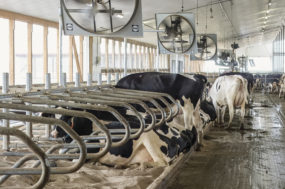Digest highlights
- IDFA announces ‘Healthy School Milk Commitment’ to provide less added sugar in school milk
- Senate passes WOTUS disapproval resolution
- Northeast milk transportation challenges analyzed
- USDA expands Margin Protection for corn and soybean producers
IDFA announces ‘Healthy School Milk Commitment’ to provide less added sugar in school milk
The International Dairy Foods Association (IDFA) is establishing the “Healthy School Milk Commitment,” a pledge by dairy companies to reduce calories and added sugars in flavored milk served in school feeding programs.
Beginning with the 2025-26 school year, 37 school milk processors – representing more than 90% of the school milk volume in the U.S. – will cut school milk options to no more than 10 grams of added sugar per 8 fluid ounce serving. According to the announcement, the standard is consistent with the latest federal Dietary Guidelines for Americans and ahead of current school meal nutrition guidelines established by the USDA.
IDFA will share graphics, a video and printed educational materials on the Healthy School Milk Commitment with partners and community members including the USDA, state governments and agencies with authority for school nutrition programs; national and state nutritionist and dietician professional organizations; state dairy organizations; and organizations committed to public health and access to nutrition.
To read more about the Healthy School Milk Commitment and to see a full list of the participating school milk processors, click here.
Senate passes WOTUS disapproval resolution
Following previous action by the House of Representatives, the Senate passed a Waters of the U.S. (WOTUS) resolution of disapproval, March 29, on a 53-43 vote.
Under the terms of the Congressional Review Act, Congress can strike down a federal agency rule if a resolution of disapproval is approved by both chambers and signed by the president.
The White House has said President Joe Biden will veto the resolution, and opponents of the rule are unlikely to muster the two-thirds majorities needed in each chamber of Congress to override a presidential veto.
Following the Senate vote, Zippy Duvall, American Farm Bureau Federation president, sent a letter to Biden urging him to repeal the WOTUS rule.
In the courts, the WOTUS rule survived a legal challenge in Kentucky. District Judge Gregory Van Tatenhove, in the U.S. District Court for the Eastern District of Kentucky, denied an injunction request by the state of Kentucky and the Kentucky Chamber of Commerce.
Read also: Court issues limited injunction on WOTUS rule
Northeast milk transportation challenges analyzed
The Farm Credit East Knowledge Exchange recently took a fresh look at milk transportation, specifically in the northeast U.S., and released its findings in a report titled, “Challenges in Northeast Milk Transportation.”
The report identified key challenges facing milk haulers to be driver shortages and aging demographics, regulation barriers, equipment supply chain issues, logistical challenges at milk plants, infrastructure limitations at farm facilities and inadequate transportation infrastructure investment.
“The logistics of getting milk from the farm to the plant are complex, expensive and fraught with challenges, but they are a key component of the dairy industry,” said Chris Laughton, Farm Credit East director of Knowledge Exchange and author of the report.
“To begin to solve for the problems identified, Farm Credit East recommends public and private investment along with streamlined regulations across state lines.”
View the report here.
USDA expands Margin Protection for corn and soybean producers
The USDA Risk Management Agency (RMA) is expanding its Margin Protection insurance plan, adding more than a thousand counties to the insurance option that provides coverage against an unexpected decrease in operating margin for corn and soybean producers.
The expansion will be available by June 30; interested producers will need to purchase coverage by Sept. 30 to be eligible for the 2024 crop year.
Margin Protection protects against decreases in margin caused by reduced county yields, reduced commodity prices, increased price of certain inputs or any combination of these issues. It is area-based, using county-level estimates of average revenue and input costs to establish the amount of coverage and indemnity payments.
The RMA’s expansion of the Margin Protection plan will add 1,255 counties in 22 states for soybeans and 1,729 counties in 34 states for corn. In the 2022 crop year, there were 1.7 million acres of corn and 1 million acres of soybeans insured under the Margin Protection insurance plan.
Margin Protection can be purchased by itself, or in conjunction with a Yield Protection or Revenue Protection policy purchased from approved insurance providers. A list of crop insurance agents is available at all USDA Service Centers and online at the RMA agent locator.






